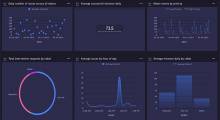Founded in 2019, California-based Robust.AI knew the bar was set high for its initial software and hardware rollout. Three years later, when its Grace software suite and Carter collaborative autonomous mobile robot (AMR) debuted, Robust set out to differentiate itself from the marketplace.
Who knew it would all come back to the bar?
“Designed with humans in mind”
Kavitha Velusamy is the senior vice president of engineering at Robust.AI. She joined the company in 2021 and has played a major role in the development of Grace and Carter. One of the first things that users will notice about Carter, and one of the things Velusamy points out about the collaborative AMR, is its design.
Simply put, it has a handlebar.
“We have designed with humans in mind, from the ground up,” she said. “What it does is to kind of raise the bar on collaboration. For example, the one thing we can talk about is the handlebar. Carter is autonomous when needed and it can be taken over by workers when needed as well. It empowers them. It's just a simple thing, but it actually helps a lot.”
While it may sound like an oxymoron - a handlebar that allows humans to move an AMR - the added flexibility of this simple design element has provided a differentiator from other robots on the market. It all goes back to the initial development of the robot and its tie-in with the Grace software suite.
“The handlebar is such a simple thing, but it actually provides so much of our affordances in controlling what the robot can do,” Velusamy said. “We don’t have and we’re not planning to have a remote operation center because of the way that we have designed a robot. We have a screen. We have a handlebar. We have other visual aids like LEDs. If the robot is in trouble for some reason, it can always indicate that, ‘I need help.’ Users can just take the handlebar, move Carter away and it can just go do whatever it's supposed to do.”
“Grace is the brain and Carter is the brawn”
What’s a collaborative AMR without a software suite gleaming a plethora of data from the fleet of robots as they maneuver around the warehouse? While Carter can run without any connection to Grace, Velusamy mentioned that the ROI for these customers won’t likely be as high as compared to running at full connection.
From the data perspective, Robust.AI needs a warehouse floor plan and layout to get started. Once a prospective customer provides that information, Robust runs simulations to evaluate robot workflows, fleet optimization and productivity gains. Next, Robust will map the physical location. Velusamy said the company recently mapped a customer’s 250,000 square foot facility in about two hours.

Grace has all this information. Now what?
“We want to call Grace the brain and Carter is the brawn,” she said.
As the braun of the operation makes its way onto the warehouse floor, the robots are talking to each other and the Grace software suite in the sky. Grace’s fleet-intelligence optimization system integrates with the customer’s WMS and the Carter AMRs, generating a huge amount of data. That’s when decision time comes in. And, as Velusamy describes it, Grace isn’t a decision engine, it’s a recommendation engine.
“Grace does make suggestions,” she said. “It picks a specific order profile, the route plan and what the robots have to do, but that also determines what the workers should be doing. Having said that, the warehouse managers have complete control over what they want the robots to do.”
“How do you move around humans?”
In February 2024, DHL and Robust.AI announced a collaboration that saw the companies piloting a deployment of Carter AMRs at the 3PL provider’s locations. Powered by Grace’s AI and machine learning capabilities, the deployment looks to enhance efficiencies in DHL warehouses.
Another integral design feature of Carter is its incorporation of visual SLAM. You won’t find on the AMRs, and this is an intentional design choice. As Velusamy noted, visual SLAM provides a rich set of data features for Robust to operate with. The resulting data feeds back to Grace, and Robust uses that data to build out better situational awareness for the robots.
“We built our stack in such a way that you can design pretty easily how you move around humans,” she said. “How do you approach them? What kind of distance do you want? How do you move away from them? If you're coming behind them, how do you want to move?”
Identifying a human, or a forklift or any obstruction in the warehouse is just part of the equation. The next step, and something Robust is working on, involves optimizing the robot to eliminate wasted movement for warehouse staff.
“If someone is picking and the robot is coming and waiting for them to pick, what angle do you want the robot to arrive and stay for them to pick? What happens if they're right handed versus left handed? There are so many nuances that we are considering and enabling in our software stack. I think it’s unique and I think it's super important for us to be successful now and in the future with where the entire logistics and warehouse space is going because humans are going to be an integral part of how we work.”
“We built the entire architecture together”
As Robust.AI turns the corner into the latter half of its first decade of existence, Velusamy echoed the same concept of intertwining the physical design of the Carter robots with the digital Grace fleet intelligence suite. One didn’t come before the other, and the combination between the two is at the crux of its platform in a crowded marketplace.
“Our fleet intelligence system is tied to the robotic stack,” she said. “We built all of them together, it's not an afterthought, The fleet management was not an afterthought. We built all of them, the entire architecture, together.”
When Carters are rolling - either autonomously or by hand - in warehouses, they’re collecting data. Grace receives and digests that data to warehouse managers in customer deployments. The hardware and software stack, collectively, are the figurative peanut butter and jelly of deployments for Robust customers.
“How the semantic information is populated on the perception AI side, how we plan paths, how we navigate, all of that is tied to the fleet,” Velusamy said. “What information do the fleets need as well? They're architected together and what it ultimately gives us is to have the right control signals for the optimization that runs in the cloud. That means better optimization, better workflows, better ROI and better planning.”
Want to learn more about fleet management? This article was featured in the June 2024 Robotics 24/7 Special Focus Issue titled “Orchestrating mobile robot fleets for success.”
About the Author
Follow Robotics 24/7 on Linkedin
Article topics
Email Sign Up

















